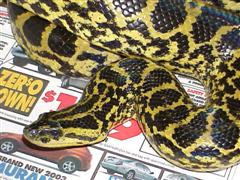Anaconda - Yellow
Paraguay Anaconda Scientific Name: Eunectes notaeus
Mon, 28th April, 2025 - 12:37 pm GMT
Sponsor Ads:

Alternative Name
Paraguay Anaconda Scientific Name: Eunectes notaeusBasic Info
While smaller than its larger relative the Green Anaconda, the Yellow Anaconda can still reach an impressive size. They can exceed fifteen feet in length, although females average less than twelve feet and males average around eight feet. They are primarily olive or yellow in color, with lots of dark markings on the back. Male Yellow Anacondas have preanal spurs near the base of the tail that are used in the courting ritual.
Health
Yellow Anacondas require a large enclosure, at least 2/3 of which is filled with water over six inches deep, and they should have plenty of places to hide. They should be kept at tropical temperatures and humidity levels. Captive Yellow Anacondas are fed primarily on appropriately sized rodents. Even captive bred specimens tend to be aggressive, and because of their great size and strength, they are only recommended for those experienced with keeping large aggressive snakes. Breeding Yellow Anacondas usually breed between March and July, after an elaborate courtship ritual that can take up to two months. They often mate in the water. Anacondas are viviparous animals, which means they give birth to live young rather than laying eggs. The female will give birth to her young, usually between 8 and 30 babies, after about five months of gestation.Habitat
Preferring water to land, the Yellow Anaconda is usually found in the swamps, marshes, rivers and streams of South America.Behavior
Smaller than the Green Anaconda, the Yellow Anaconda is a large and striking boa. Although the Yellow Anaconda prefers to hunt live prey, they will also scavenge for animals that are already dead. Anacondas are well known for their rather aggressive disposition. Even a "tame" Anaconda that has been kept in captivity all its life may bite without warning. Luckily, the Anaconda's bite is not poisonous. It is, however, very powerful and can cause considerable tissue damage. Anacondas can be very difficult to spot in the wild because they have very little difficulty camouflaging themselves. This snake is not as common in captivity as some other snakes because of its aggressive personality. Although Anacondas are not often kept as pets, some people do acquire them. Then, when they begin to grow quite large and their owner can no longer handle their aggressive disposition, they are handed off to zoos or rescue organizations, or even released into the wild.Origin
South AmericaHistory
The Yellow Anaconda can be found in Paraguay, Argentina, Bolivia, and South Brazil. In Brasil this snake is called Sucuri Amarela, which means "yellow sucuri".Common Foods
It is one of the smaller species of Anacondas and, while its larger relatives often feed on whole deer, the Yellow Anaconda's diet generally consists of smaller animals like heron, egrets, rodents, caimans, fish, and ducksSponsor Ads:
Why long for glory, which one despises as soon as one has it? -- Unknown
Anaconda - Yellow
Coded by: BGID® | ALL RIGHTS RESERVED Copyright © 2000-2025
Disclaimer | Privacy | Report Errors / Contact | Credits


 Preparing For China. China is growing their military. China Military Technology - can it keep up with the US?
Preparing For China. China is growing their military. China Military Technology - can it keep up with the US?  versus
versus 

 versus
versus 
 This Thread is about the North Korean Military itself - the kind of army, navy, and air force they have.
This Thread is about the North Korean Military itself - the kind of army, navy, and air force they have. 
 versus
versus 
 versus
versus  versus
versus